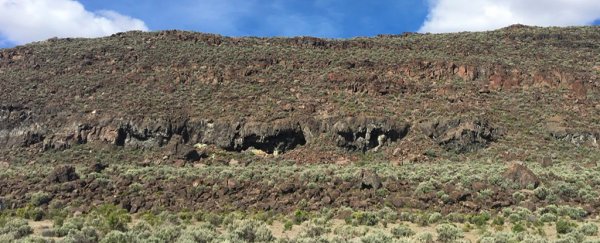The question of when human settlers first arrived in North America is not an easy one to answer, but archaeologists now have another piece of useful evidence to work from – a new study of 14,000-year-old poop.
Found in the well-known Paisley Caves in Oregon, the faeces add to the growing consensus that human history on the continent pre-dates the Clovis culture thought to have been established about 11,500 years ago.
While the DNA of this dried-out dung has been analysed before, the latest study takes a different tack, looking for traces of lipids – the fatty biological materials, including cholesterol, that are found in the guts of humans and animals.
 (John Blong/Newcastle University)
(John Blong/Newcastle University)
"The question of when and how people first settled the Americas has been a subject of intense debate," says geoarchaeologist Lisa-Marie Shillito from Newcastle University in the UK.
"By using a different approach, we have been able to demonstrate that there were pre-Clovis populations present in the area of the Great Basin and resolve this debate once and for all."
While the ancient poop samples – coprolites, to give their technical name – had been dated using radiocarbon techniques, there had been some debate over whether they were actually from humans. A lot of DNA contamination and sediment shift can happen across the course of 14,000 years.
Contamination is much less likely to occur during analysis of lipids, which preserve better than DNA; taken with previous findings, the new research suggests these faeces are indeed human in origin, and that there were in fact people living here all that time ago.
Dog lipids were mixed in with the human ones, indicating that canine companions were living alongside people in this era. It's another sign of domesticated living, as are fragments of basket-making materials also recovered at the site, with carbon dating of the latter corroborating the lipid analysis results.
"Our study addresses persistent criticisms of the DNA evidence for the earliest human occupation of the Paisley Caves," geoarchaeologist John Blong from Newcastle University told Gizmodo.
"We address issues of potential DNA contamination through faecal lipid biomarker analysis, providing evidence that there likely was DNA moving from younger human occupations into older cave sediments and coprolites, but also confirming that people were camping at the caves as early as 14,200 years ago."
Not all of the poop samples analysed were matched to humans, but more than half of them were, and two were from the oldest 14,000-year-old batch. Besides telling scientists more about the history of the caves, it's another reminder of the benefits of using multiple identification methods together.
The samples recovered from the Paisley Caves have the honour of being the oldest coprolites ever discovered in the western hemisphere, but humans might have arrived even earlier and just not left as much poop around. As new artefacts are discovered and analysed, the estimated date might continue to get pushed back.
And while there's plenty more still to learn about how people made their way to the Americas, the research team is also interested in discovering more about the habits and the traditions of these distant civilisations, almost lost in time. The dung hints at a diverse diet involving seeds, rodents, insects and plants.
"So far, there has been a lot of focus on answering the when and how of how people arrived on the continent," says Shillito. "As a result, the nature of early occupation has received relatively little attention, in terms of understanding the relationship between these early human populations and their environment."
"We want to know more about the people themselves. This was a time when the environment was very different and changing rapidly. We want to know how they adapted to this change, what they were eating and how this changed over time."
The research has been published in Science Advances.
